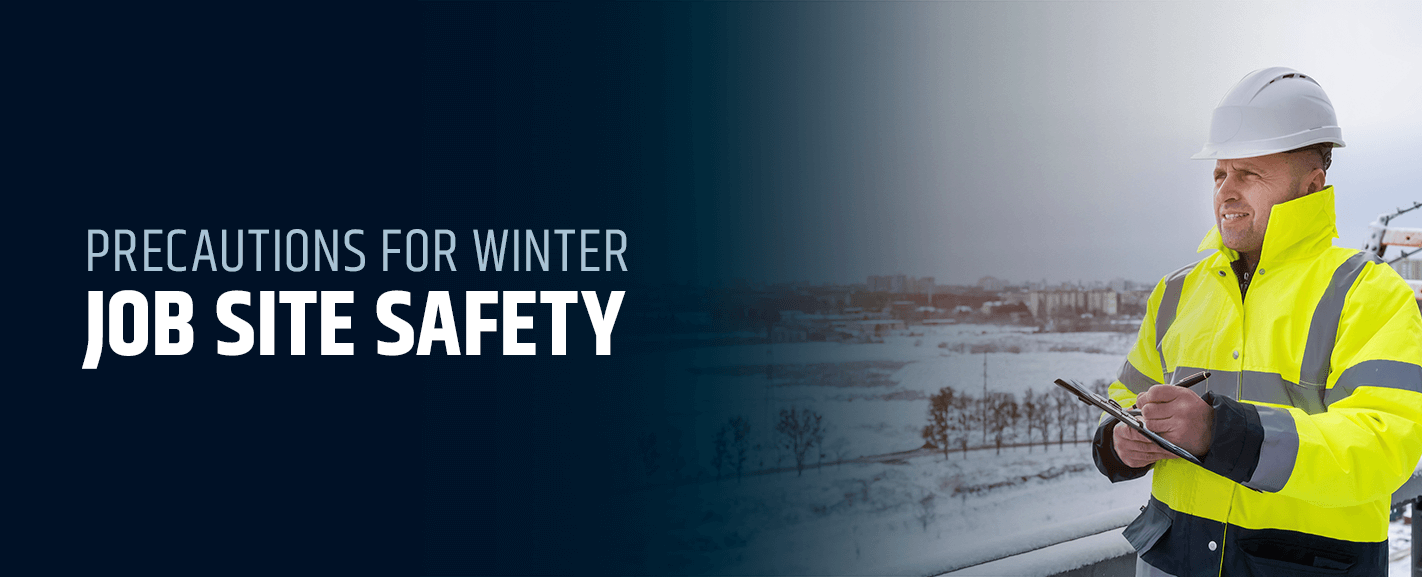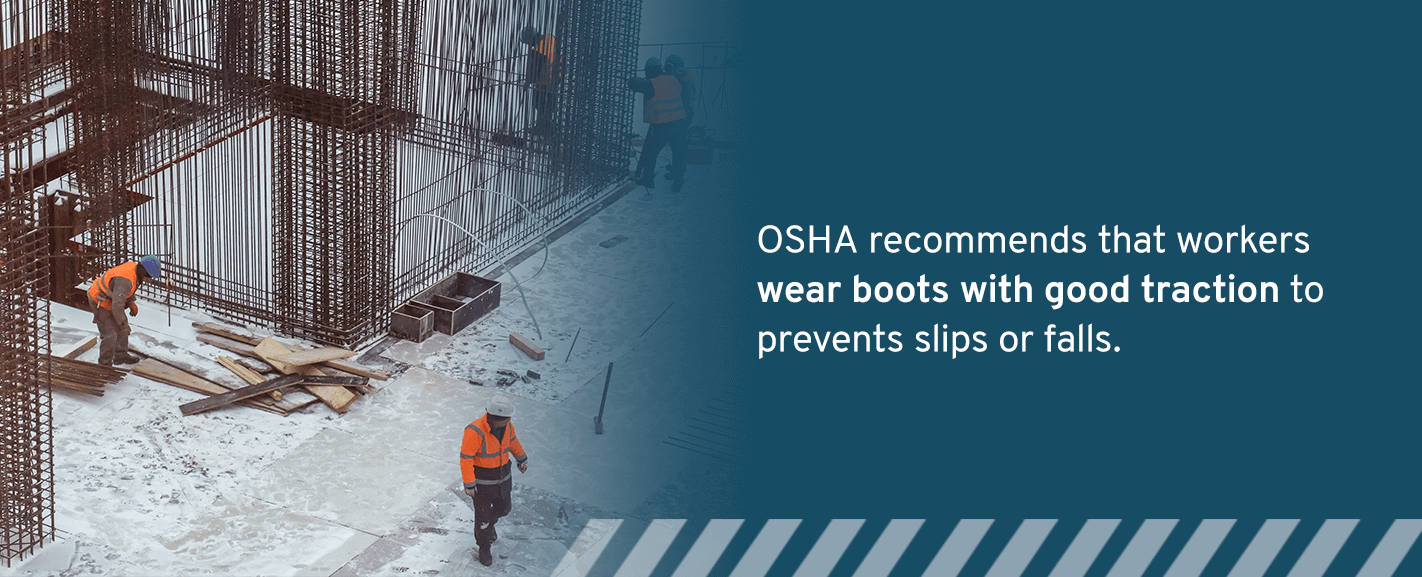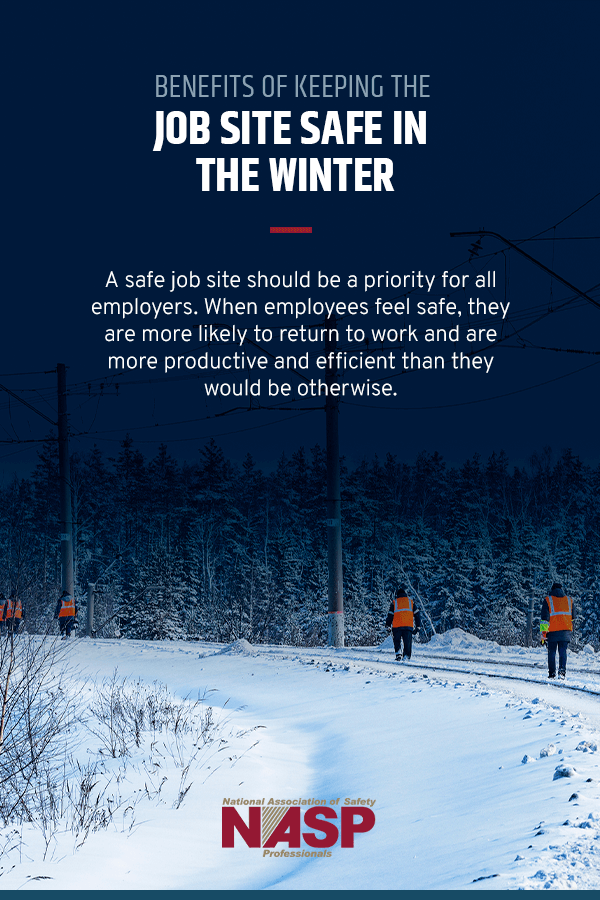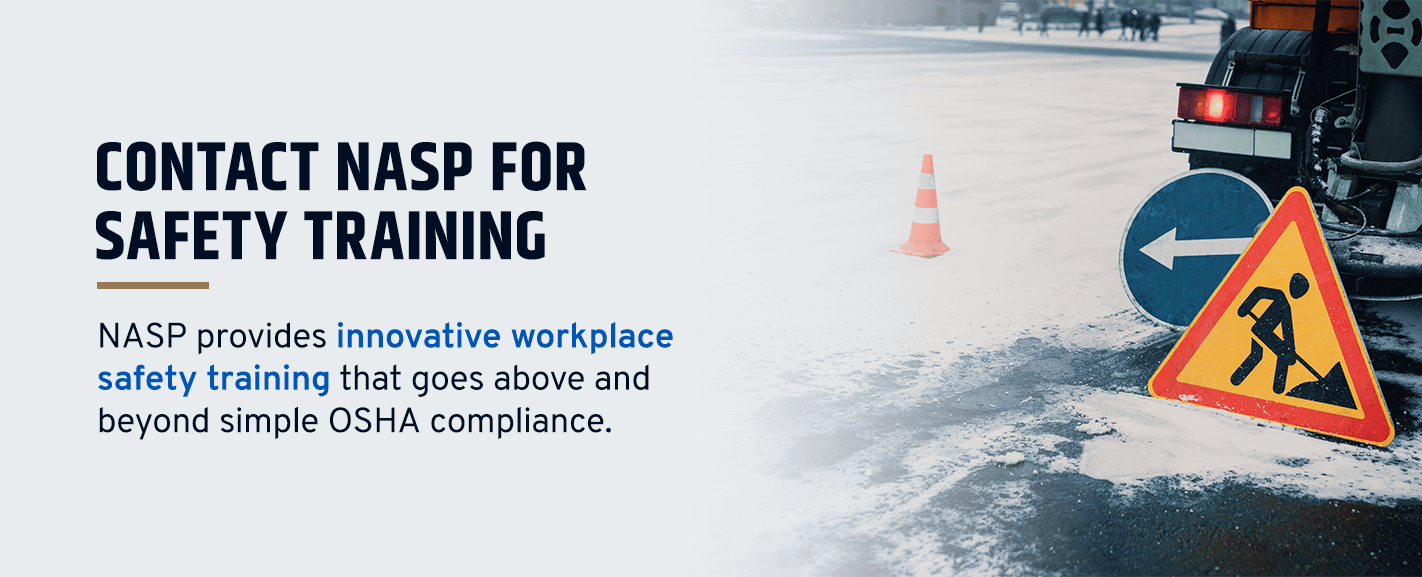Precautions for Winter Job Site Safety

Jump To:
- Potential Risks and Dangers of Job Sites in the Winter
- Benefits of Keeping the Job Site Safe in the Winter
- Winter Job Site Safety Training
Construction work can be one of the most dangerous jobs out there. Workers are typically surrounded by heavy equipment that can be dangerous when mishandled and are often around hazardous materials or chemicals, which can result in health problems for those involved. Many jobs also require workers to be high off the ground, which can result in falls or other accidents. As the seasons change and winter draws nearer, the working conditions at a job site have the potential to become even more hazardous. All employers and their employees should be aware of the dangers that exist and how they can prevent injuries as a result of them.
Potential Risks and Dangers of Job Sites in the Winter
Working at a job site in winter conditions can be dangerous, particularly when precautions aren’t taken. In a workplace that has neglected to implement the proper safety provisions, workers can become susceptible to injuries due to falls or slips. Injuries on the job can be easily prevented if the proper methods are taken to make the environment secure. All employers are responsible for ensuring the safety of their employees, meaning that they should be taking the appropriate safety measures to make the working environment as safe as possible.
There are many ways to create the best possible working conditions when winter weather strikes. Listed below are a few of the most important steps you can take to help prevent job site accidents in the winter. It’s important to be aware of what you can do on the job site for your workers, but it is also vital knowledge for employees so they can be cautious as well. There is no substitute for proper training to avoid injury on the job.
View NASP’s Safety Course Catalog
Monitor Physical Conditions
Working in the cold is never a pleasant experience for anyone, but knowing just how much our bodies can handle when it comes to cold weather is key to preventing illness and injuries due to extreme temperatures. When we are cold, our body responds by working hard to keep us warm. It is our body’s natural instinct to protect our internal organs, so when we start to get too cold, blood will shift from our extremities, such as our hands and feet, and move to our center. If the body continues to remain in cold temperatures for extended periods with insufficient protection, then we will start to shiver, which is our body’s way of keeping us warm.
In inadequate working situations, these bodily reactions can leave you susceptible to conditions such as frostbite or hypothermia. If working conditions are also wet from rain or snow, it does not have to be nearly as cold to cause cold stress symptoms as it would have to be in a dry environment. This is why it is so important to pay attention to the weather conditions and how you and your coworkers are reacting to the environment. Being aware of what such weather can do to your body plays a big part in preventing any injuries that result from the cold.
Wear Appropriate Clothing
When we get cold, we often reach for more clothing to layer on our bodies and prevent the cold from seeping in. This is also a practice that should be carried over into the workplace. In a lot of cases, avoiding cold weather entirely is impossible, so dressing for the occasion can help keep the dangers of cold weather at bay.
It is always a good idea to layer clothing to provide the best insulation possible and protect against harsh winds. Much of our body heat is released from our heads, so having a harm hat on hand is also ideal for keeping your body warm. If you’re working in a wet environment or expecting rain or snow, having waterproof boots that are comfortable and warm is crucial to protecting yourself from the elements. Finally, it is also important to protect your face and hands from harsh weather. Investing in a mask and a good pair of gloves will help you stay protected from the harshest conditions.
Employers should provide their employees with a list of proper clothing for working conditions and should require these items to be worn in order to prevent cold-related injuries. The Occupational Safety and Health Administration (OSHA) still requires high visibility gear and clothing to be worn, so keep that in mind when layering for the cold.
Review Worksites and Upcoming Weather Conditions
Weather can change on a dime, so it is important to monitor the weather in your area when workers are going to be at the job site. Keeping an eye on forecasts will allow you to prepare and wear the most appropriate clothing for the conditions. Your local area should provide public warnings during inclement weather, which are often relayed through radio, social media, and sirens. Have a plan in place so that in the event of these adverse weather conditions, your employees are able to evacuate the site as quickly and safely as possible.
Reviewing the worksite and making sure that it is safe is also important. Worksites should be monitored every day and cleared of any obstructions that may pose a risk to workers. This can include any snow or ice build-up, which can result in injuries.
Watch for Freezing and Thawing Effects
It is not uncommon for temperatures to fluctuate in the winter. These temperature changes can result in dangerous working conditions if the job site is not properly monitored. Snow and ice will often melt when temperatures start to warm up when the sun is high but refreeze overnight when the temperatures drop once again. This can result in slippery work surfaces, which can leave workers vulnerable to falls, potentially resulting in serious injury. Any build-up of ice has the potential to be dangerous, and icy patches are not always easy to spot.
Using ice melts or shoveling away snow can help, but contact suppliers to determine which melting chemicals are best. In some situations, the only viable option is to wait for the ice or snow to melt later in the day before continuing work.
Remove Snow and Ice
As mentioned briefly before, snow and ice build-up can result in dangerous working conditions. In these harsh winter weather conditions, falls become more likely, so it is always a good idea to get rid of snow and ice on the job site where possible. This should be done before any work is commenced on the job site. There are chemicals available that can assist with melting the ice, and large pieces of ice can be chipped away. Ice that hangs or snow that has built up on roofs should be removed as well, as it has a high chance of falling and injuring anyone below it.
Review Walking and Working Surfaces
Walking and working surfaces, when improperly managed, have the greatest potential for injury at a job site. All of these surfaces are required by OSHA to be kept clear and free of hazards. In the winter, these areas should be monitored frequently to check for snow or ice build-up. If found, this build-up should be removed as quickly as possible.
Purchase the Walking-Working Surface and Fall Protection Specialist Course
In some scenarios, snow and ice may not be able to be removed. If this is the case, then extra precautions should be taken around these surfaces. OSHA recommends that workers wear boots with good traction to prevents slips or falls as well as taking short steps in order to increase reaction time.
Limit Exposure to the Elements
Sometimes, the weather outside can become too extreme to work in for long periods of time. In cases such as these, it is recommended to limit the time that workers are exposed to these dangerous weather conditions. This can be easily done by shortening the length of outdoor shifts and allowing frequent breaks in an area with heat, such as a trailer or indoor break room. If the weather gets so extreme that working safely is impossible, work should be scheduled for a later date or time so that workers aren’t needlessly exposed to the harsh conditions.
Inspect and Prepare Vehicles
Work vehicles play a big part in construction, and any malfunction can put a job behind schedule. To prepare for the winter, all vehicles should be properly inspected to ensure that they can withstand harsh conditions and low temperatures. Vehicles that aren’t maintained will not operate as well in colder conditions. Having vehicles inspected by a professional will let you know if work vehicles are able to perform well in the cold.
Winter weather is known to cause a plethora of issues in all types of vehicles, such as dead batteries and thickening of oil. One of the best ways to prepare for the winter is to know what the cold can potentially do to your vehicles and how to prevent it, which will extend their life and usefulness.
An extra step that employers can take is prepping vehicles with winter emergency kits so that workers can be prepared if dangerous weather conditions arise. These kits often include things like food, water, blankets, flashlights, shovels and tow chains, but there are many other useful items that can be included. Your location and what winter will look like for you will determine what materials need to be provided.
Educate Workers on the Signs of Frostbite and Hypothermia
Many people are unaware of what frostbite or hypothermia looks like unless they have experienced it before. Employees should be provided with this knowledge so they are better equipped to see the signs, act quickly to prevent any further damage, and contact medical professionals. Hypothermia and frostbite are serious conditions that can result in permanent damage if treatment is not received in time.
Hypothermia begins as the result of our bodies being unable to replace heat at the speed in which they are losing it. It often starts with shivering as the body attempts to keep itself warm. Internal body temperature begins to drop, and the body begins to present more symptoms, such as pale skin, slurred speech and lack of coordination. When hypothermia progresses too far, people often describing feeling warm and have been known to remove layers due to this phenomenon. This is when hypothermia can get particularly dangerous because people begin to expose themselves to even more of the elements, which will only quickens the condition.
Frostbite is another serious condition that can occur due to cold weather conditions. When the body gets cold, it shifts the blood flow from the extremities to the core in order to keep internal organs warm. When the extremities, such as the hands or feet, get too cold then they are prone to frostbite. The symptoms to look out for include skin discoloration, starting with red, then going to purple, and then a very pale or white color. The area will also feel cold to the touch and may sting or tingle before going numb. In the most severe cases, the body part may need to be amputated.
When working on a job site in the winter, keep a lookout for these symptoms. Knowing what they are and how they can present themselves is the best way to spot these conditions and prevent them from becoming harmful to workers on a job site.
Benefits of Keeping the Job Site Safe in the Winter
A safe job site should be a priority for all employers. When employees feel safe, they are more likely to return to work and are more productive and efficient than they would be otherwise. Less work time will be lost if conditions are kept in check and the number of incidents will lessen.
One of the major benefits of taking the necessary precautions for winter weather is that workers will experience less pain and injury. When left unchecked, winter weather conditions will produce numerous hazards that will leave the entire workforce vulnerable to injury. Falls would be frequent and the chances of frostbite and hypothermia are drastically increased. When workers are injured on the job, they will most likely file for worker’s compensation which will result in money lost on the employer’s part.
It is beneficial for both the employer and the employee to have a safe work environment. Taking all the necessary safety precautions for winter will help prevent job site accidents that are not only costly to the employer but are more importantly painful and damaging to the employee who sustained the injury. Everyone involved with such a job site should take the time to be properly trained and should strictly adhere to the training so that they are able to manage these harsh winter conditions when they arise.
Contact NASP for Safety Training
There are many risks associated with working on a construction site, especially in the winter months. Fortunately, there are also many precautions that can be taken to prevent injury and job site accidents, but nothing can beat being properly trained for such conditions. NASP provides innovative workplace safety training that goes above and beyond simple OSHA compliance. With our robust training, you and your employees will be more than prepared for any harsh winter conditions that come your way. For more information, contact us today to speak with our qualified staff.
Contact Us for Job Site Safety Training
Blog Posts
Latest Posts
Related Posts








